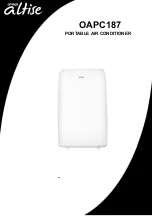
English
13
4.
When routing out the transmission wiring from the opening
for piping.
5.
When routing out the power/ground wires from the front.
6.
Clear over 2 in..
7.
When routing out the transmission wiring from the knockout
hole.
8.
Retain to the back of the column support with the accessory
clamp (2).
9.
When routing out the power/ground wires from the right side.
10.
Power wiring
11.
Transmission wiring
12.
Ground wire
Precautions when knocking out knockout holes
•
To punch out a knockout hole, hit it with a hammer.
•
Open an appropriate hole as needed.
•
After knocking out the holes, trim off the burr, then we recommend
you to paint the edges and areas around the edges using the repair
paint to prevent rusting.
•
Power line : Open a knockout hole as shown at left and connect
it using a conduit.
•
Transmission line : Connect it using a conduit in the knockout hole
on the right.
NOTE
•
After wiring work is completed, check to make sure there are no loose
connections among the electrical parts in the EL.COMPO.BOX.
8.
AIR TIGHT TEST AND VACUUM DRYING
•
After finished piping work, carry out air tight test and vacuum drying.
NOTE
•
Always use nitrogen gas for the airtightness test.
•
Absolutely do not open the shutoff valve until the main power ciruit
insulation measurement has been completed. (measuring after the
shutoff valve is opened will cause the insulation value to drop.)
<Needed tools>
<The system for air tight test and vacuum drying>
•
Referring to figure 25, connect an nitrogen tank, refrigerant tank, and
a vacuum pump to the outside unit.
The refrigerant tank and the charge hose connection to refrigerant
charge port or the valve A in figure 25 are needed in
“11. ADDI-
TIONAL REFRIGERANT CHARGE AND CHECK OPERATION”
.
(Refer to figure 25)
1.
Gauge manifold
2.
Nitrogen
3.
Measuring device
4.
R410A tank (with siphon)
5.
Vacuum pump
6.
Charge hose
7.
High side equalizer pipe shutoff valve
8.
Gas pipe shutoff valve
9.
Low side equalizer pipe shutoff valve
10.
Liquid pipe shutoff valve
11.
Refrigerant charge port
12.
Valve A
13.
Valve B
14.
Valve C
15.
Outside unit
16.
Indoor unit
17.
Shutoff valve
18.
Service port
19.
Field piping
20.
Gas flow
NOTE
•
The air-tightness test and vacuum drying
should be done using the service ports of
equalizer pipe, HP/LP gas pipe, suction gas
pipe and liquid pipe shutoff valve.
See the [R410A] Label attached to the front
plate of the outside unit for details on the loca-
tion of the service port (see figure at right)
•
See
[Shutoff valve operation procedure]
in
“11-1 Before working”
for details on handling
the shutoff valve.
•
The refrigerant charge port is connected to unit pipe.
When shipped, the unit contains the refrigerant, so use caution when
attaching the charge hose.
<Air tight test>
Pressurize the liquid pipe, suction gas pipe, HP/LP gas pipe and
equalizer pipe from the service ports of each shutoff valve to 478 psi
(do not pressurize more than 478 psi). If the pressure does not drop
within 24 hours, the system passes the test.
If there is a pressure drop, check for leaks, make repairs and perform
the airtight test again.
<Vacuum drying>
Evacuate the system from the liquid pipe, suction gas pipe, HP/LP
gas pipe and equalizer pipe shutoff valve service ports by using a
vacuum pump for more than 2 hours and bring the system to
–14.6 psi or less. After keeping the system under that condition for
more than 1 hour, check if the vacuum gauge rises or not. If it rises,
the system may either contain moisture inside or have leaks.
NOTE
If moisture might enter the piping, follow belows.
(I.e., if doing work during the rainy season, if the actual work takes
long enough that condensation may form on the inside of the
pipes, if rain might enter the pipes during work, etc.)
After evacuating the system for 2 hours, pressurize the system to 7.25
psi (vacuum break) with nitrogen gas and evacuate the system again
using the vacuum pump for 1 hour to –14.6 psi or less (vacuum drying).
If the system cannot be evacuated to –14.6 psi within 2 hours, repeat
the operation of vacuum break and vacuum drying.
Then, after leaving the system in vacuum for 1 hour, confirm that the
vacuum gauge does not rise.
9.
PIPE INSULATION
•
Insulation of pipes should be done after performing “
8. AIR TIGHT
TEST AND VACUUM DRYING
”.
•
Always insulate the liquid piping, the HP/LP gas piping, the gas pip-
ing, the equalizer pipe (between the outside units for the outdoor
multi system) and these pipe connections.
Failing to insulate the pipes may cause leaking or burns.
Especially, be sure to insulate the HP/LP gas piping as withstanding
as the suction pipe because the suction gas follows in the HP/LP gas
piping when the system is whole cooling mode.
And be sure to use the insulation which can withstand such temper-
atures of 248°F or more for the HP/LP gas piping, the equalizer pipe
and the gas piping because the HP/LP gas follows in these pipings.
Gauge manifold
Charge hose
valve
•
To prevent entry of any impurities and insure
sufficient pressure resistance, always use the
special tools dedicated for R410A.
•
Use charge hose that have pushing stick for
connecting to service port of shutoff valves or
refrigerant charge port.
Vacuum pump
•
The vacuum pump for vacuum drying should
be able to lower the pressure to –14.6 psi.
•
Take care the pump oil never flow backward
into the refrigerant pipe during the pump stops.
Burr
Knockout hole
Left side
Right side
Lock nut
Conduit
mounting
plate
Conduit
[R410A] Label
01_EN_3P215731-2.fm Page 13 Tuesday, December 4, 2007 12:04 PM
Summary of Contents for RXYQ120PYDN
Page 24: ...20 English NOTES...









































